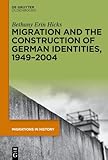Migration and the Construction of German Identities, 1949–2004 / Bethany Erin Hicks.
Material type: TextSeries: Migrations in History ; 2Publisher: München ; Wien : De Gruyter Oldenbourg, [2023]Copyright date: ©2023Description: 1 online resource (VI, 161 p.)Content type:
TextSeries: Migrations in History ; 2Publisher: München ; Wien : De Gruyter Oldenbourg, [2023]Copyright date: ©2023Description: 1 online resource (VI, 161 p.)Content type: - 9783110716122
- 9783110716269
- 9783110716221
- 305.8
- online - DeGruyter
- Issued also in print.
| Item type | Current library | Call number | URL | Status | Notes | Barcode | |
|---|---|---|---|---|---|---|---|
 eBook
eBook
|
Biblioteca "Angelicum" Pont. Univ. S.Tommaso d'Aquino Nuvola online | online - DeGruyter (Browse shelf(Opens below)) | Online access | Not for loan (Accesso limitato) | Accesso per gli utenti autorizzati / Access for authorized users | (dgr)9783110716221 |
Browsing Biblioteca "Angelicum" Pont. Univ. S.Tommaso d'Aquino shelves, Shelving location: Nuvola online Close shelf browser (Hides shelf browser)

|

|

|

|

|

|

|
||
| online - DeGruyter Investigations of Explanatory Strategies in Linguistics / | online - DeGruyter Wissenschaftsforschung / | online - DeGruyter Formen des Essayistischen : Paradigmen einer Schreibästhetik bei Walter Benjamin / | online - DeGruyter Migration and the Construction of German Identities, 1949–2004 / | online - DeGruyter Die Vita des koptischen Klostergründers Pachom : Synoptische Darstellung, Übersetzung und Analyse / | online - DeGruyter Europäische Grundrechte und Grundfreiheiten / | online - DeGruyter The Compact Compendium of Experimental Philosophy / |
Frontmatter -- Contents -- Introduction -- 1 “Vertriebene” or “Umsiedler”? Postwar and Cold War Migration and the (Re)Formation of German Identities, 1945–1949 -- 2 Republikflucht and Gastarbeiter: Migration Regimes Within and Between the Two Germanies, 1949–1989 -- 3 Tearing Down One Wall While Erecting Another: GDR Refugees in the West Before and After the Fall of the Berlin Wall, 1989–1990 -- 4 Emigration Becomes Internal Migration – A New German Minority and a Crisis of National Identity, 1991–1994 -- 5 German Mobility and a New Generation, 1994–2004 -- 6 Conclusion -- Bibliography -- Index
restricted access online access with authorization star
http://purl.org/coar/access_right/c_16ec
Migration, in its many forms, has often been found at the center of public and private discourse surrounding German nationalism and identity, significantly influencing how both states construct conceptions of what it means to be "German" at any given place and time. The attempt at constructing an ethnically homogeneous Third Reich was shattered by the movement of refugees, expellees, and soldiers in the aftermath of the Second World War, and the contracting of foreign nationals as Gastarbeiter in the Federal Republic and Vertragsarbeiter in the German Democratic Republic in the 1960s and 70s diversified the ethnic landscape of both Cold War German states during the latter half of the Cold War. Bethany Hicks shows how the regional migration of East Germans into the western federal states both during and after German unification challenged essential Cold War assumptions concerning the ability to integrate two very different German populations.
Issued also in print.
Mode of access: Internet via World Wide Web.
In English.
Description based on online resource; title from PDF title page (publisher's Web site, viewed 06. Mrz 2024)


